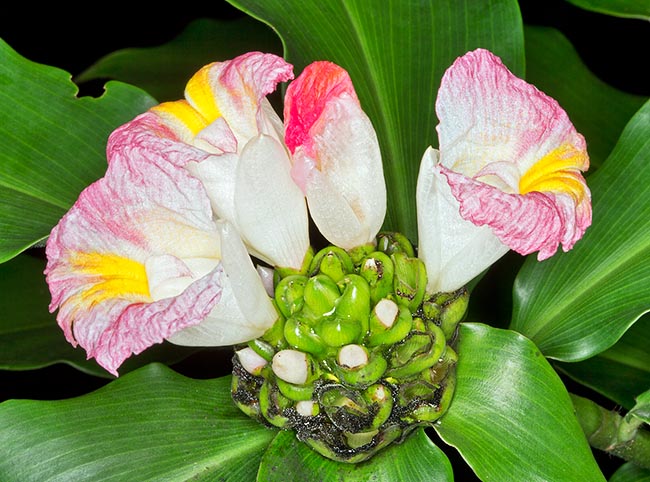Family : Costaceae

Text © Pietro Puccio

English translation by Mario Beltramini

Costus lucanusianus inflorescence. The yellow band leads the bees to the nectar. Medicinal virtues © G. Mazza
Common names: African spiral flag, spiral ginger (English); canne d’eau (French).
The Costus lucanusianus J.Braun & K.Schum. (1889) is an evergreen, perennial rhizomatous herbaceous species, with thin stems 1,5-3 m tall and simple leaves, entire, spirally arranged, with closed tubular sheath of green colour and 1,5-3 mm long ligula, coriaceous, provided with hairs.
The leaves, on 0,5-1 cm long petiole, are lanceolate or oblong-lanceolate with pointed apex, 20-24 cm long and 4,5-7 cm broad, smaller in correspondence with the inflorescence, with margin and lower page slightly hairy.
Terminal sessile inflorescence, globose, compact, 3,5-10 cm long, formed by oblong green bracts, coriaceous, enclosing an hermaphrodite flower with tubular, 2 cm long, green calyx, with curved triangular, 0,5 cm long, lobes, tubular corolla about 1,5 cm long with lanceolate lobes about 2,5 cm long, from semi-transparent to white; a petaloid fertile free stamen, triangular, 3 cm long and 1 cm broad, of white colour with reddish apex, and 5 fertile stamina merged to form a petaloid labellum with wavy margins, about 4 cm long and broad, white streaked of purple red and crossed by a yellow central band which acts as “guide” for the pollinating insects (bees).
The fruit is an ellipsoid capsule about 1,5 cm long containing several black seeds with white aril. It reproduces by seed, which is to be interred as soon as possible as it has a short lasting germinability, in loam rich of humus with addition of sand or perlite for a 30%, kept humid and in shaded position, at the temperature of 22-26 °C, and, easily, by division and through the young plants it produces on the inflorescence.
Species that in central Africa is often present in the family gardens being all parts of the plant variously utilized since remote times for various pathologies. Besides as medicinal plant, it is often used as ornamental for its flowers with their showy labellum, which last singularly one day only, but which are continuously produced.
It is cultivable in the tropical and subtropical humid climate zones in full sun or partial shade in draining soils rich of humus. It adapts also to the cultivation in capacious pots for the decoration of patios and terraces, besides verandas and winter gardens, where the climate does not allow the permanency in open air during the coldest months, with temperatures above the 15 °C, utilizing a draining substratum rich of organic substance; watering must be regular and abundant in summer, more spaced in winter, but without allowing the loam to dry up completely.
Synonyms: Costus dussii K.Schum. (1904).
→ To appreciate the biodiversity within the family COSTACEAE please click here.
